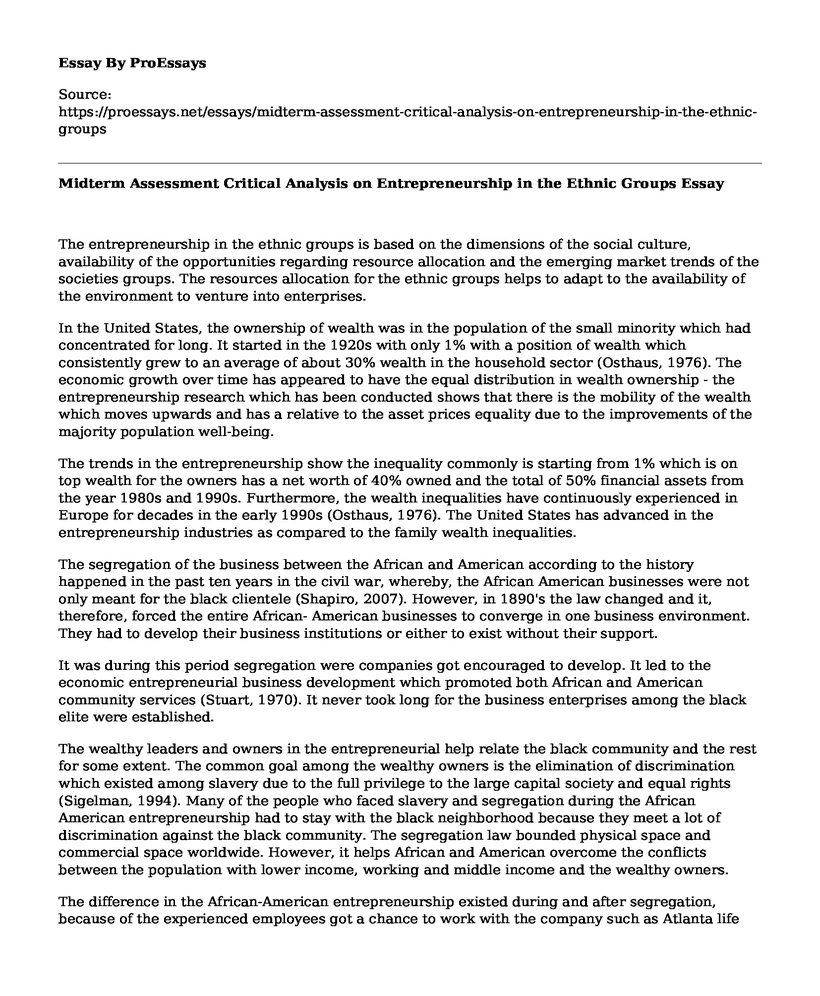The entrepreneurship in the ethnic groups is based on the dimensions of the social culture, availability of the opportunities regarding resource allocation and the emerging market trends of the societies groups. The resources allocation for the ethnic groups helps to adapt to the availability of the environment to venture into enterprises.
In the United States, the ownership of wealth was in the population of the small minority which had concentrated for long. It started in the 1920s with only 1% with a position of wealth which consistently grew to an average of about 30% wealth in the household sector (Osthaus, 1976). The economic growth over time has appeared to have the equal distribution in wealth ownership - the entrepreneurship research which has been conducted shows that there is the mobility of the wealth which moves upwards and has a relative to the asset prices equality due to the improvements of the majority population well-being.
The trends in the entrepreneurship show the inequality commonly is starting from 1% which is on top wealth for the owners has a net worth of 40% owned and the total of 50% financial assets from the year 1980s and 1990s. Furthermore, the wealth inequalities have continuously experienced in Europe for decades in the early 1990s (Osthaus, 1976). The United States has advanced in the entrepreneurship industries as compared to the family wealth inequalities.
The segregation of the business between the African and American according to the history happened in the past ten years in the civil war, whereby, the African American businesses were not only meant for the black clientele (Shapiro, 2007). However, in 1890's the law changed and it, therefore, forced the entire African- American businesses to converge in one business environment. They had to develop their business institutions or either to exist without their support.
It was during this period segregation were companies got encouraged to develop. It led to the economic entrepreneurial business development which promoted both African and American community services (Stuart, 1970). It never took long for the business enterprises among the black elite were established.
The wealthy leaders and owners in the entrepreneurial help relate the black community and the rest for some extent. The common goal among the wealthy owners is the elimination of discrimination which existed among slavery due to the full privilege to the large capital society and equal rights (Sigelman, 1994). Many of the people who faced slavery and segregation during the African American entrepreneurship had to stay with the black neighborhood because they meet a lot of discrimination against the black community. The segregation law bounded physical space and commercial space worldwide. However, it helps African and American overcome the conflicts between the population with lower income, working and middle income and the wealthy owners.
The difference in the African-American entrepreneurship existed during and after segregation, because of the experienced employees got a chance to work with the company such as Atlanta life (Spinosa, 1997). Additionally, there were no competitions and the opportunity to venture into entrepreneurship and develop skills, an excellent working environment and solidarity in the family were available.
Conclusion
In conclusion, the entrepreneurship gap between the African-American remains persistently large. It is because of the segregation because of the policy interventions against the black families which cluster the entrepreneurship either black or poor categories.
References
Oliver, M. L., and T.M. Shapiro. 2007. 'Wealth and racial equality.' In Michael T. Martin and Marilyn Yaquinto (eds.) Redress for Historical Injustices in the United States: On Reparations for Slavery, Jim Crow, and Their Legacies. Durham and London: Duke University Press.
Osthaus, C. R. 1976. Freedmen, Philanthropy, and Fraud: A History of the Freedman's Savings Bank. Chicago: University of Illinois Press.
Rutheiser, C. 1996. Imagineering Atlanta: The Politics of Place in the City of Dreams. London: Verso.
Sigelman, L. and S. Welch. 1994. Black Americans' Views of Racial Equality: The Dream Deferred. Cambridge University Press: New York, NY.
Spinosa, C., F. Flores, and H. Dreyfus. 1997. Disclosing New Worlds: Entrepreneurship, Democratic Action, and the Cultivation of Solidarity. Cambridge and London: MIT Press.
Stuart, M. S. 1970. An Economic Detour: A History of Insurance in the Lives of American Negroes. New York: Wendell Malliet and Company.
Cite this page
Midterm Assessment Critical Analysis on Entrepreneurship in the Ethnic Groups. (2022, Nov 06). Retrieved from https://proessays.net/essays/midterm-assessment-critical-analysis-on-entrepreneurship-in-the-ethnic-groups
If you are the original author of this essay and no longer wish to have it published on the ProEssays website, please click below to request its removal:
- Essay Sample on Reasons for Wanting to Study
- Clinical and Mental Health Counseling Admission Essay
- Paper Example on Servicescape and Authenticity in Michelin Restaurant Dining
- Essay Example on Social Construction: Understanding Meaning in Society
- Essay Example on Starbucks: Purchasing, Roasting, and Selling High-Quality Coffee
- Essay Example on Exploring My Interest in Health-Related Fields: A Journey of Self-Discovery
- Essay on My Objectivist Beliefs: How Self-Interest, Reason, Capitalism, and Reality Unify







